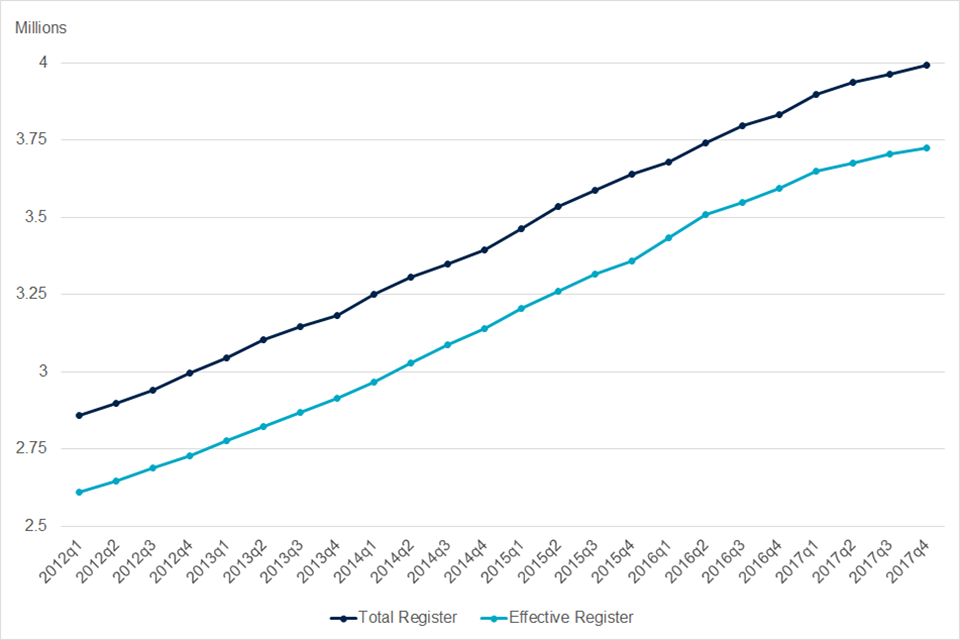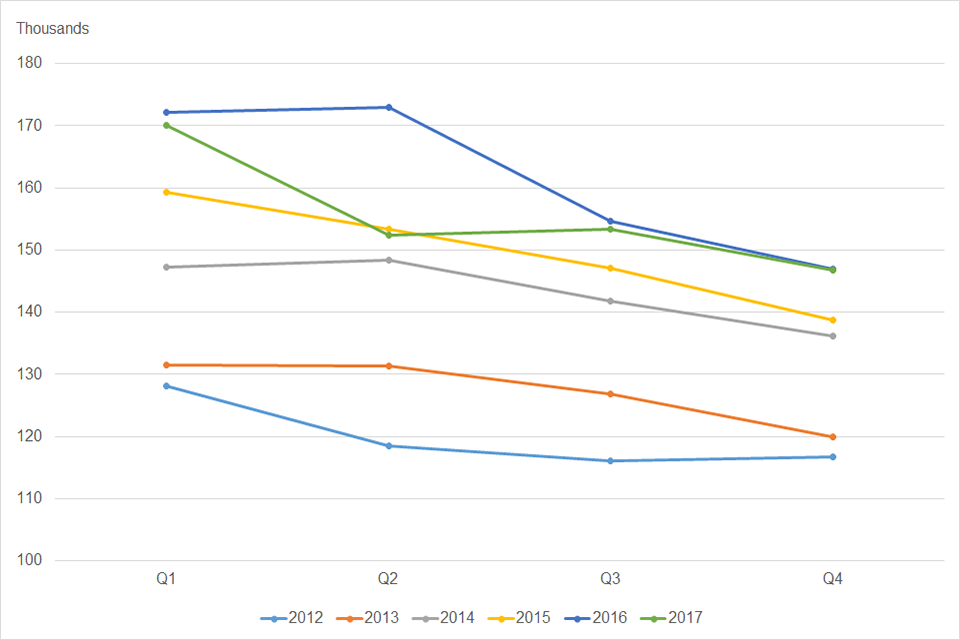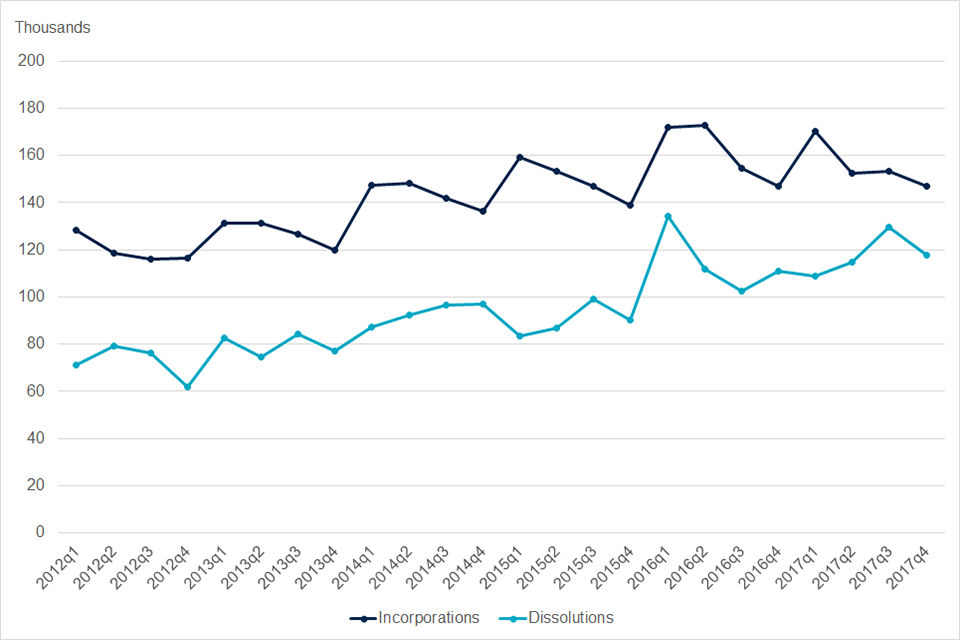Incorporated companies in the UK: October to December 2017
Published 25 January 2018
1. Introduction
This release provides information about the population of companies in the United Kingdom. A company is defined as a specific legal form of business formed under the Companies Act 2006. Companies are registered at Companies House regardless of whether they go on to trade actively. Further information on companies and the Companies Act 2006 is provided in the document Definitions to accompany statistical releases.
The statistics in this release include the total number of incorporated companies, the number of newly incorporated companies and the number of companies that were dissolved. The release focusses on the headline messages for the United Kingdom. Figures for the constituent countries are contained in the supplementary tables that accompany this release. The supplementary tables also contain separate figures for public companies and limited liability partnerships.
1.1 Key points
- Between October and December 2017, there were 146,852 company incorporations and 117,545 dissolutions in the UK.
- At the end of December 2017, there were 3,993,232 companies on the total register and 3,725,610 companies on the effective register. Both the total and effective registers have continued to increase in size since the beginning of 2012.
- There were slightly fewer incorporations during the final quarter of 2017 compared with the final quarter of 2016.
- The number of dissolutions during the final quarter of 2017 was slightly lower than the third quarter of 2017. Overall, however, the number of dissolutions has increased since the final quarter of 2016.
- Despite seasonal trends, the numbers of incorporations and dissolutions have increased overall since 2012.
2. Incorporated companies
Between October and December 2017, there were 146,852 company incorporations and 117,545 dissolutions in the UK. At the end of the period, the number of companies on the total register - including those in the process of dissolution or liquidation (267,622) - reached 3,993,232. This was an increase of 31,446 (0.8%) companies compared with the end of the previous quarter.
Both the number of incorporations and dissolutions decreased in the final quarter of 2017 compared with the third quarter of 2017. However, this led to an increase in the register size overall. This was driven by the decrease in the number of incorporations being less than the number of dissolutions in this period. Total numbers on the registers for England and Wales, Scotland and Northern Ireland increased by 0.8%, 1.3% and 1.1% respectively.
The effective register, which excludes companies in the process of liquidation or dissolution, stood at 3,725,610 at the end of December 2017, an increase of 22,475 companies (0.6%) compared with the previous quarter.
When comparing the final quarter of 2017 with the final quarter of 2016, the UK total register increased by 159,763 (4.2%), while the effective register increased by 132,008 (3.7%). Both the total and effective registers have continued to increase in size in a linear fashion since the beginning of 2012.
2.1 Chart 1: Total and effective register sizes, 2012q1-2017q4, United Kingdom

Chart 1: Total and effective register sizes, 2012q1-2017q4, United Kingdom
Source: Incorporated Companies in the UK October to December 2017, Companies House
The number of new incorporations in the third and final quarter of 2017 followed a similar trend of that of previous years, where the number of incorporations declined towards the end of the year. In recent years, the number of incorporations for the same quarter each year has increased; however, when comparing the final quarter of 2017 with the final quarter of 2016, the difference in new incorporations is only 135 (0.1%).
2.2 Chart 2: Incorporations by year and quarter, 2012-2017, United Kingdom

Chart 2: Incorporations by year and quarter, 2012-2017, United Kingdom
Source: Incorporated Companies in the UK October to December 2017, Companies House
Despite the slight decreases in the number of incorporations during 2017, the number of incorporations overall has increased over time. There were 18,650 (14.5%) more incorporations in the final quarter of 2017 than in the first quarter of 2012, and 30,310 (26.0%) more incorporations in the final quarter of 2017 than in the final quarter of 2012.
Due to the introduction of legislation that shortened the process of voluntary and compulsory dissolutions by one month, there was a spike in the number of dissolutions during the first quarter of 2016. Although the number of dissolutions subsequently returned to previous levels, they have continued to increase overall since the third quarter of 2016. There were 6,412 (5.8%) more dissolutions in the final quarter of 2017 compared with the final quarter of 2016.
As with incorporations, the number of dissolutions has increased since 2012. There were 46,227 (64.9%) more dissolutions in the final quarter of 2017 than in the first quarter of 2012 and 49,110 (79.2%) more dissolutions in the final quarter of 2017 than in the final quarter of 2012.
2.3 Chart 3: Incorporations and dissolutions, 2012q1-2017q4, United Kingdom

Chart 3: Incorporations and dissolutions, 2012q1-2017q4, United Kingdom
Source: Incorporated Companies in the UK October to December 2017, Companies House
A full breakdown of figures for England and Wales, Scotland, Northern Ireland and the UK as a whole is provided in the Excel workbook that accompanies this release. Figures are provided both at the quarterly and the yearly level for the years 2011 onwards.
3. Other statistics in this release
In addition to the tables covering register activity for all companies, a range of other statistics are included in the tables that accompany this release. These tables provide information at the individual country level and for the UK as a whole.
The tables cover the following:
- register activity for public companies
- register activity for limited liability partnerships (LLPs)
- company insolvencies and liquidations
- removals from the register
4. Background notes
This section provides a range of information designed to provide the user with more information about the statistics.
4.1 Definitions
A separate document Definitions to accompany statistical releases is available, providing definitions for the main terms used in Companies House official statistics publications.
4.2 Quality
Information relating to the quality of the statistics is provided in a separate quality document. This document provides information on the quality of Companies House’s official statistics, to enable users to judge whether or not the data are of sufficient quality for their intended use. The information is structured in terms of the quality dimensions of the European Statistical System. The document also provides information on how these statistics relate to selected other business statistics.
4.3 Coverage
This release provides information on the size of the company population and the changes that have occurred within the quarter. The release includes statistics for the United Kingdom, England and Wales, Northern Ireland, and Scotland. The statistics cover companies, which are specific legal forms of businesses that are registered at Companies House. They do not include information on sole proprietorship businesses, partnerships, and charities.
4.4 Use and users
Companies House statistics are used extensively by government, the public, public bodies and businesses. For example, they are used by:
- Government in understanding the likely impact of policy changes and monitoring the impact of economic changes on companies;
- Businesses in understanding their market share and planning marketing strategies;
- Banks in developing an understanding of their customer base;
- Foreign firms in making UK location decisions;
- Academics to inform research into businesses at local and national level;
- A range of public bodies in decision making and evaluating business-related policies.
4.5 Revisions to these statistics
Revisions to these statistics will be mainly due to changes in methodologies and source data. The statistics are derived from administrative data, and changes to the underlying methods will cause revisions. These include changes in statistical methods, definitions, classifications, and geographic coverage.
Although Companies House has robust procedures in place to minimise errors in the methods used to create these statistics, errors may occasionally occur. If errors are found after the publication, their impact will be assessed. If the changes are significant, a correction will be issued as soon as possible. Minor corrections will be included in the next planned release.
Any misleading or incorrect figures will be amended and a footnote added to indicate that the figures have been corrected. The nature and reason for the correction will be explained.
4.6 Date of next release
Statistics for the period 1 January to 31 March 2018 will be published on 26 April 2018. The publication date has been announced on the GOV.UK release calendar.
